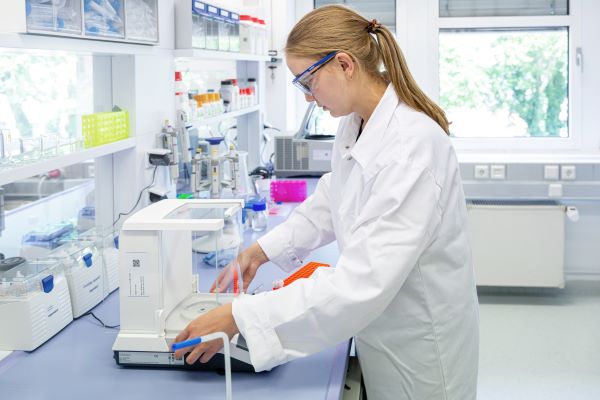Fraunhofer IMS successfully completes insituBIOS project | Reading time 3 min.
With established building blocks for biohybrid nanosensor technology and expanded laboratory infrastructure, the project paves the way for innovative applications.
The Fraunhofer Institute for Microelectronic Circuits and Systems IMS completed the project with clear results: A powerful laboratory ecosystem for nanosensor technology has been established, technological foundations have been laid, and the path to applications has been paved with pilot and feasibility studies. InsituBIOS was realized as part of the Fraunhofer Attract funding program, which enables outstanding external scientists to implement their ideas in a market-oriented, application-oriented environment.
The goal of insituBIOS (biohybrid, highly sensitive nanosensors for in situ diagnostics in biomedicine and environmental analysis) was to develop biohybrid, highly sensitive nanosensors that detect chemical and biological species quickly, specifically, and as directly as possible in the application environment—from tissues and body fluids in biomedical diagnostics to environmental analysis. One focus at Fraunhofer IMS is on optical sensors that use special fluorescence signals in the near-infrared range (780–1700 nm) and can thus measure through tissue and fluids without contact. This results in precise, integrable sensor components for infection diagnostics, disease monitoring, environmental and pollutant detection, and process control in biotechnology and chemical engineering.
Results in figures
• 21 scientific publications
• 4 successfully completed doctorates
• 15 bachelor's and master's theses
• 9 newly launched projects
• 5 invention disclosures (IP basis)


Laboratory infrastructure: Scalable, integrated, application-oriented
Thanks to project funding from insituBIOS and additional strategic investments, the laboratory facilities at Fraunhofer IMS have been significantly expanded. A total of around 120 m² of new biological laboratory space has been created, in which the planned biological safety level and the necessary structural measures have been almost completely implemented. This has resulted in the creation of nanomaterial and biosensor areas with semi-automated workflows for sensor integration, microstructured functional surfaces, automated sample handling, and testing processes. These are supplemented by workstations for the cultivation of cells and microorganisms—including sterile handling processes, autoclaves, incubators—as well as for molecular biological and diagnostic procedures.
In addition, approximately 50 m² of laboratory space has been set up for optical and physicochemical analysis. This includes the characterization of functionalized materials, the testing of biosensors, and infrastructures for Process Analytical Technology (PAT) in bioprocess engineering.
Technological milestone
With the completion of insituBIOS, key building blocks for nanosensor development at Fraunhofer IMS have been established. Building on this, the team has demonstrated TRL 4 maturity levels in pilot and feasibility studies – the step from scientific idea to robust, application-oriented demos has been taken.
Applications and competence building
The knowledge and experience gained in the insituBIOS project open up a wide range of application prospects. Among other things, they contribute to pharmaceutical research, for example in the fields of cell therapies, lab-on-chip systems, and bioimaging. The developments also offer great potential for in vitro and companion diagnostics – particularly in the detection of infections, diseases of the central nervous system, and in oncology.
In addition, pilot and feasibility studies with practical demonstrators were implemented at technology readiness level 4 (TRL 4), preparing the transfer to concrete applications.
With its research areas “Nanosensors for Biomedical Applications,” “Smart Surfaces,” and “Hyperspectral NIR Imaging,” Fraunhofer IMS is positioning itself for technology transfer in industry and the healthcare system. Customer benefits include fast, precise, and contact-free detection of a wide range of analytes, high sensitivity and flexibility, integration into existing workflows, and customizable sensor and optics development.
Fraunhofer Attract: Bridging the gap between excellent research and industry
InsituBIOS is part of the Fraunhofer Attract program, which Fraunhofer uses to attract excellent scientists with innovative ideas and high transfer potential. Within this framework, Fraunhofer IMS was able to recruit Prof. Dr. Sebastian Kruss from Ruhr University Bochum for the institute. His expertise was crucial for the successful implementation of insituBIOS and the establishment of new areas of expertise at IMS.
Fraunhofer Attract enables the establishment of independent research groups with personnel and budget responsibility, promotes scientific qualification, and supports the transfer to market-oriented applications. This creates new fields of research and business, while Fraunhofer further strengthens its role as a driver of innovation through IP development, follow-up projects, licensing, and potential long-term spin-offs.
Outlook
With the infrastructure it has created, its IP base, and follow-up projects, Fraunhofer IMS is continuing to expand a new R&D segment in nanosensor technology. The goal is to work with partners from the pharmaceutical, diagnostics, environmental, and process technology sectors to transfer scalable systems from the pilot phase to clinical and industrial applications.
Further information Details on nanosensors at Fraunhofer IMS: